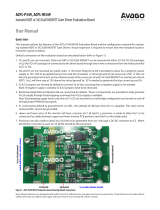
Broadcom
- 6 -
ACPL-C799 Evaluation Kit Board
User Guide
Measurement
Measurement
Figure 7 Measurement
There are few ways to apply the input signal into the evalboard:
Apply input current signal with Shunt Resistor
One example to select the shunt resistor value is shown below:
If maximum rms current through motor = 100A, 20 percent overloads during normal operation, then, peak current is 170 A
(= 100 × 1.414 × 1.2). Recommended maximum input voltage for ACPL-C799 = ±50mV.
Shunt resistor value = V/I = 50mV/170A ≈ 0.3m
Power dissipation = I
2
× R = (100)
2
× 0.3m = 3W
The shunt resistor mounting pad is designed to accommodate various shunt resistor package types. The Kelvin connection
PCB trace connects from the center of the pad to the inputs of ACPL-C799 through the anti-aliasing filters (AAFs). Connecting
from the center of the pads is usually the optimum location for most shunt resistor designs. The evalboard also provides pads
P1 and P2 for soldering thick cables to the motor driving board.
Apply input voltage signal without shunt resistor
Connect the audio cable with the audio 3.5-mm jack connected to either a PC, smart phone, tablet, MP3 player, or any kind of
audio player device. Then, connect the crocodile clips to the shunt resistor mounting pads.
By checking the 1kHz sine test signal, you can supply a 1 kHz sine wave voltage signal into the evaluation board. Other
methods include running any of the three sine wave files provided from a music player software program in audio player
devices as described previously. Adjust the volume until the signal level is near ±50mV or ±20,000 ADC counts for best
SNR/SNDR performance.
The performance of SNR/SNDR is dependent on a few factors:
— The evalboard
— The sigma-delta modulator used, in this case, the ACPL-C799
— Input signal frequency used
— The decimation ratio, which can be set at the application GUI to 256, 128, 64, or 32.
— The input signal level. ACPL-C799 recommended input voltage range is from –50mV to 50mV. To achieve the best
SNR/SNDR, it is recommended to design the maximum input signal range near to ±50mV (selection of input current range
and shunt resistor value).
— The input signal source.
Table 2 shows a comparison of the SNR/SNDR performance between audio signal source coming from a laptop and a smart
phone.
















